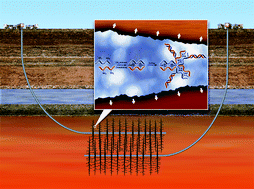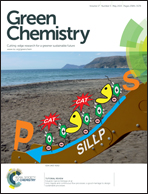Stimuli-responsive/rheoreversible hydraulic fracturing fluids as a greener alternative to support geothermal and fossil energy production†
Abstract
Cost-effective yet safe creation of high-permeability reservoirs within deep bedrock is the primary challenge for the viability of enhanced geothermal systems (EGS) and unconventional oil/gas recovery. Although fracturing fluids are commonly used for oil/gas, standard fracturing methods are not developed or proven for EGS temperatures and pressures. Furthermore, the environmental impacts of currently used fracturing methods are only recently being determined. Widespread concerns about the environmental contamination have resulted in a number of regulations for fracturing fluids advocating for greener fracturing processes. To enable EGS feasibility and lessen environmental impact of reservoir stimulation, an environmentally benign, CO2-activated, rheoreversible fracturing fluid that enhances permeability through fracturing due to in situ volume expansion and gel formation is investigated herein. The chemical mechanism, stability, phase-change behavior, and rheology for a novel polyallylamine (PAA)-CO2 fracturing fluid was characterized at EGS temperatures and pressures. Hydrogel is formed upon reaction with CO2, and this process is reversible (via CO2 depressurization or solubilizing with a diluted acid) allowing potential removal from the formation and recycling, decreasing environmental impact. Rock obtained from the Coso geothermal field was fractured in laboratory-scale experiments under various EGS temperatures and pressures at significantly (at least an order of magnitude) lower effective stress than standard fracturing fluids, and the fractures were characterized with imaging, permeability measurement, and flow modeling. Although additional work is required to further understand the fluid properties, potential and limitations, this novel fracturing fluid and process represent a potential alternative to conventional fracturing fluids to vastly reduce water usage and the environmental impact of fracturing practices and effectively make EGS production and unconventional oil/gas exploitation cost-effective and cleaner.


 Please wait while we load your content...
Please wait while we load your content...